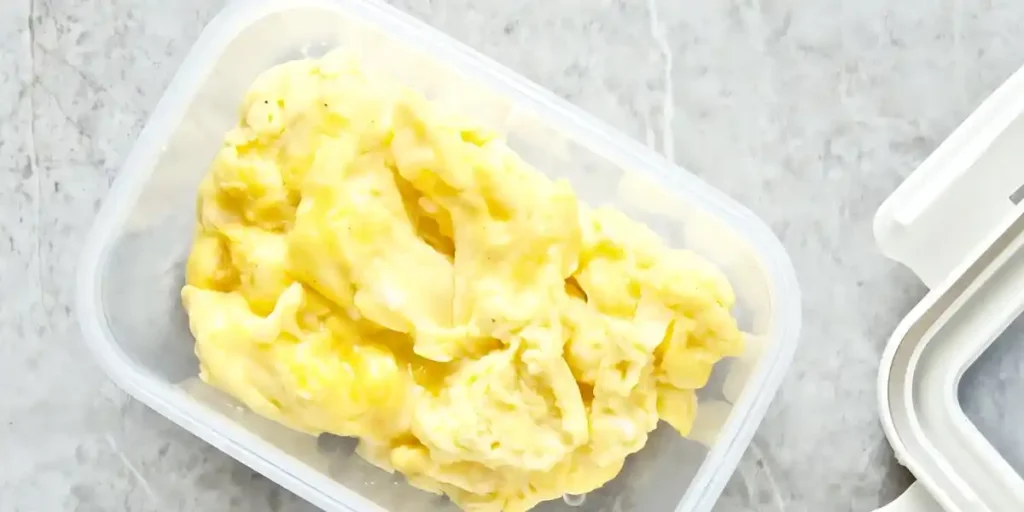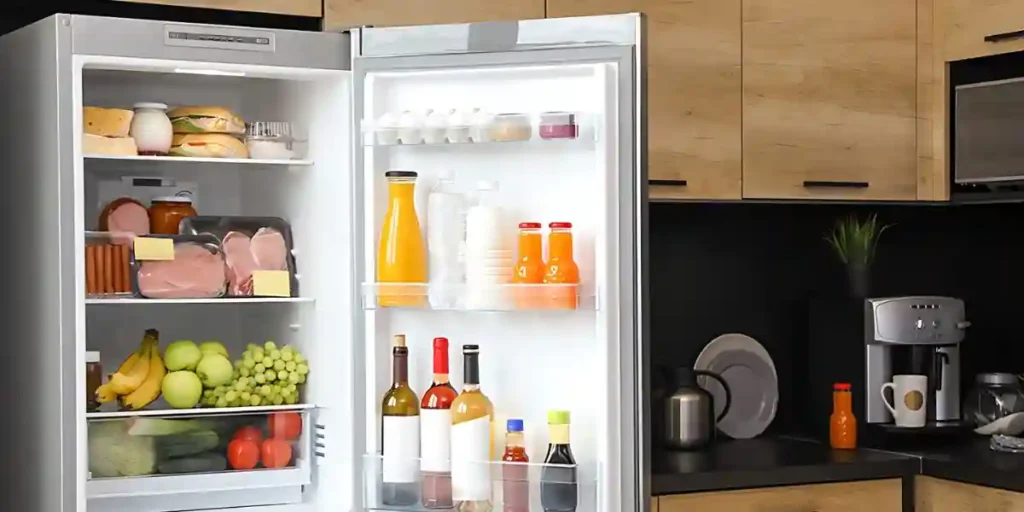How long can you keep those delicious scrambled eggs in the refrigerator? We all love a hearty breakfast, but it’s important to know how long our food stays safe and tasty.
Whether you’ve got leftover scrambled eggs or you’re planning ahead, understanding the shelf life of scrambled eggs is essential.
In this article, we’ll dive into the guidelines, storage tips, and signs of spoilage, ensuring you can enjoy your scrambled eggs worry-free.
Let’s crack open the fridge and explore how long scrambled eggs are good for in the refrigerator.

How Long Are Scrambled Eggs Good for in the Refrigerator?
Scrambled eggs are good in the refrigerator for up to four days. Ensure they are stored in a covered container at or below 40°F (4°C) to maintain freshness and safety. Remember to check for any signs of spoilage before consuming.
Factors Affecting the Shelf Life of Scrambled Eggs
By considering these factors, you can ensure that your scrambled eggs remain fresh and safe for consumption:
1. Temperature:
The temperature at which scrambled eggs are stored plays a crucial role in determining their shelf life.
Refrigeration is key, as it helps slow down bacterial growth and maintain freshness.
Store scrambled eggs in the refrigerator at or below 40°F (4°C) to maximize their shelf life.
2. Storage Container:

The type of container used for storing scrambled eggs also affects their shelf life.
Opt for airtight containers or resealable bags to prevent moisture loss and protect the eggs from absorbing odors from other foods in the refrigerator.
3. Freshness of Eggs:
The freshness of the eggs used to make the scrambled eggs impacts their shelf life.
If you start with fresh eggs, your scrambled eggs will have a longer shelf life compared to using eggs close to their expiration date.
Always check the expiration date before cooking.
4. Handling and Contamination:
Proper handling and avoiding contamination are crucial factors. Ensure that utensils, bowls, and pans used for making and storing scrambled eggs are clean and free from bacteria.
Avoid cross-contamination by storing scrambled eggs separately from raw meat and poultry.
5. Time Since Cooking:
The duration since the scrambled eggs were cooked also affects their shelf life. As time passes, the quality and safety of the eggs can deteriorate.
Consume refrigerated scrambled eggs within four days to minimize the risk of foodborne illnesses.
Signs of Spoilage in Scrambled Eggs
1. Unpleasant Odor:

When examining scrambled eggs, be alert for any unusual or foul odors. Spoiled eggs can emit a strong, sulfurous smell.
If you detect a pungent or rotten odor, it’s a clear sign that the scrambled eggs have gone bad. Trust your nose and discard them.
2. Sliminess:
Freshly made scrambled eggs should have a moist yet firm texture. However, if you notice a slimy or slippery consistency, it’s an indication of spoilage.
This sliminess can be caused by bacterial growth, and consuming such eggs can pose health risks. It’s best to avoid eating them.
3. Discoloration:
Scrambled eggs should have a vibrant, yellow color. Any discoloration, such as a greenish or grayish hue, is a sign of spoilage.
This discoloration may be a result of bacteria multiplying and can be an indication of the presence of harmful microorganisms. Discard discolored scrambled eggs.
4. Unusual Taste:
Trust your taste buds when it comes to scrambled eggs. If you take a bite and notice an off or sour taste, it’s a strong indication that the eggs have spoiled.
Spoiled eggs can harbor harmful bacteria, and consuming them can lead to foodborne illnesses. It’s better to be safe and avoid eating them.
5. Texture Changes:

Pay attention to the texture of scrambled eggs. If they feel grainy, gritty, or have a strange, rubbery consistency, it’s likely that they have started to spoil.
These textural changes can occur due to bacterial growth or improper storage. Don’t take any chances and discard eggs with altered texture.
Extending the Shelf Life of Scrambled Eggs: Storage Tips
Proper storage is essential for extending the shelf life of scrambled eggs and maintaining their quality. Follow these tips to keep your scrambled eggs fresh for longer:
1. Transfer to airtight containers:
After cooking the scrambled eggs, transfer them to airtight containers. Airtight containers prevent moisture loss and protect the eggs from absorbing odors from other foods in the refrigerator.
2. Allow cooling before refrigeration:
Before storing scrambled eggs in the refrigerator, allow them to cool at room temperature for a short period.
This helps prevent condensation inside the container, which can lead to moisture buildup and faster spoilage.
3. Label with date:
To keep track of the storage time, label the container with the date of preparation.
This helps you know when the scrambled eggs were made and when they should be consumed or discarded.
4. Store at the right temperature:

Place the airtight container with the scrambled eggs in the refrigerator as soon as they have cooled.
Set the refrigerator temperature at or below 40°F (4°C) to slow down bacterial growth and maintain freshness.
5. Avoid temperature fluctuations:
Try to minimize temperature fluctuations by keeping the refrigerator door closed as much as possible.
Fluctuations in temperature can affect the quality and safety of the scrambled eggs.
6. Separate from raw meat and poultry:
Store scrambled eggs separately from raw meat and poultry to avoid cross-contamination.
Keep them in a designated area or on a different shelf to prevent any potential bacterial transfer.
7. Consume within four days:
While proper storage can extend the shelf life of scrambled eggs, it’s important to consume them within four days to ensure food safety.
After four days, the risk of bacterial growth and spoilage increases significantly.
How to Use Leftover Scrambled Eggs?
Leftover scrambled eggs don’t have to go to waste! Instead, transform them into delicious meals and snacks with these creative ideas:
1. Scrambled Egg Breakfast Burritos:
Wrap the leftover scrambled eggs in a tortilla along with some shredded cheese, diced vegetables, and cooked bacon or sausage.
Roll it up and enjoy a satisfying breakfast on the go.
2. Scrambled Egg Muffins:
Preheat your oven and grease a muffin tin. In a bowl, mix the leftover scrambled eggs with chopped vegetables, cheese, and cooked meat.
Spoon the mixture into the muffin cups and bake until set. These make convenient and portable breakfast or snack options.
3. Scrambled Egg Fried Rice:
Sauté some diced vegetables and cooked rice in a pan with a little oil. Add the leftover scrambled eggs and stir-fry until heated through.
Season with soy sauce or your favorite spices for a flavorful and quick meal.
4. Scrambled Egg Salad:
Chop the leftover scrambled eggs and mix them with mayonnaise, mustard, chopped celery, and seasonings of your choice.
Serve the egg salad on a bed of lettuce, between slices of bread, or as a filling for wraps.
5. Scrambled Egg Quesadillas:

Spread a layer of leftover scrambled eggs onto a tortilla, then top with shredded cheese and any desired additions like sautéed onions, bell peppers, or cooked bacon.
Place another tortilla on top and cook the quesadilla on a griddle or in a skillet until golden and the cheese has melted.
6. Scrambled Egg Stuffed Peppers:
Cut bell peppers in half and remove the seeds and membranes. Fill each pepper half with the leftover scrambled eggs, then top with shredded cheese.
Bake in the oven until the peppers are tender and the cheese is bubbly and golden.
7. Scrambled Egg Wrap:
Spread a thin layer of cream cheese or hummus on a tortilla. Add the leftover scrambled eggs, along with your favorite toppings such as sliced avocado, spinach, tomatoes, or cooked bacon.
Roll up the tortilla tightly and slice it into bite-sized pieces.
8. Scrambled Egg Breakfast Bowl:
Create a nutritious breakfast bowl by combining the leftover scrambled eggs with cooked quinoa or rice, sautéed vegetables, and a protein of your choice.
Top it off with a drizzle of sauce or a sprinkle of fresh herbs.
FAQs
1. Can I Freeze Scrambled Eggs For Later Use?
Yes, you can freeze scrambled eggs. However, the texture may change upon thawing, resulting in a slightly different consistency.
It’s recommended to consume frozen scrambled eggs within one to three months.
2. Are Scrambled Eggs Safe To Eat If Left At Room Temperature?
No, scrambled eggs should not be left at room temperature for more than two hours.
Bacteria can grow rapidly in the “danger zone” between 40°F (4°C) and 140°F (60°C), potentially causing foodborne illnesses.
3. Can I Reheat Refrigerated Scrambled Eggs?
Yes, you can reheat refrigerated scrambled eggs. Ensure they are reheated to an internal temperature of 165°F (74°C) to kill any bacteria that may have multiplied.
Reheat only the amount you intend to eat to avoid multiple reheating cycles.
Conclusion
With proper storage and attention to food safety guidelines, you can enjoy the deliciousness of scrambled eggs for up to four days in the refrigerator.
Remember to keep them in airtight containers, maintain a temperature below 40°F (4°C), and be mindful of signs of spoilage.
By following these steps, you can savor your scrambled eggs while ensuring their freshness and minimizing any health risks.
So go ahead, whip up those eggs, and enjoy them at their best!
